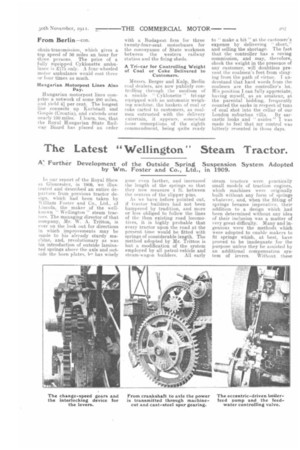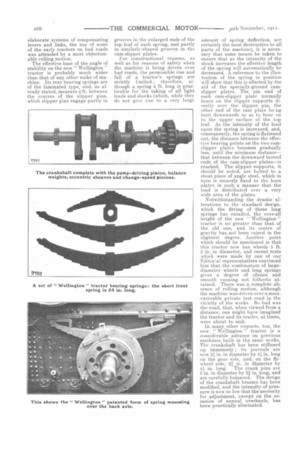The Latest "Wellington" Steam Tractor.
Page 5

Page 6

If you've noticed an error in this article please click here to report it so we can fix it.
A: Further Development of the Outside Spring Suspension System Adopted by Wm. Foster and Co., Ltd., in 1909.
In our report of the Royal Show at Gloucester, in 1909, we illustrated and described an entire departure from previous tractor design, which had been taken by William Foster and Co., Ltd., of Lincoln, the maker of the wellknown " Wellington " steam tract ors. The managing director of that company, Mr. W. A. Tritton, is ever on the look out for directions in which improvements may be made to his already sturdy machine, and, revolutionary as was his introduction of outside laminated springs above the axle and out
the horn plates, h— has wisely gone even farther, and increased the length of the springs so that they now measure 4 ft. between the centres of the slipper pins. As we have before pointed out, if tractor builders had not been hampered by tradition, and more or less obliged to follow the lines of the then existing road locomotives, it is highly probable that every tractor upon the road at the present time would be fitted with springs of considerable length. The method adopted by Mr. Litton is but a modification of the system employed by all petrol-vehicle and steam-wagon builders. All early steam tractors were practically small models of traction engines, which machines were. originally built without any form of springs whatever, and, when the fitting of springs became imperative, their addition to a design which had been determined without any idea of their inclusion was a matter of very great difficulty. Many and ingenious were the methods which were adopted to enable makers to fit springs which, at best., have proved to be inadequate for the purpose unless they be assisted by an additional compensation system of levers. Without these elaborate systems of compensating levers and links, the use of some of the early tractors on bad roads was attended by a most objectionable rolling motion. The effective base of the angle of stability on the new " Wellington " tractor is probably much wider than that of any other make of machine. Its rear bearing springs are of the laminated type, and, as already stated, measure 4 ft. between the centres of the slipper pins, which slipper pins engage partly in grooves in the enlarged ends of the top leaf of each spring, and partly in similarly-shaped grooves in the cam-slipper plates. For constructional reasons, as well as for reasons of safety when the machine is being driven over bad roads, the permissible rise and fall of a tractor's springs are strictly limited; therefore, although a spring 4 ft. long is practicable for the taking of all light loads and shocks (which, while they do not give rise to a very large amount of spring deflection, are certainly the most destructive to all parts of the machine), it is neces sary that some means be taken to ensure that as the intensity of the shock increases the effective length of the spring will automatically be decreased. A reference to the illus tration of the spring in position will show that this is effected by the aid of the specially-ground cam slipper plates. The pin end of each cam-slipper plate normally bears on the slipper supports di rectly over the slipper pin, the other end of the cam plate beng bent downwards so as to bear on to the upper surface of the top leaf. As the intensity of the load upon the spring is increased, and, consequently, the spring is flattened out, the distance between the effective bearing points on the two camslipper plates becomes gradually less, until the minimum distance— that between the downward turned ends of the cam-slipper plates—is reached. The slipper supports, it should be noted, are bolted to a stout piece of angle steel, which in turn is securely fixed to the horn plates in such a manner that the load is distributed over a very wide area of the plates.
Notwithstanding the drastic alterations to the standa.rd design, which the fitting of these long springs has entailed, the over-all height of the new " Wellington " tractor is no greater than that of the old one, and its centre of gravity has not been raised in the slightest degree. Another point which should be mentioned is that this tractor now has wheels 5 ft.
2 in. in diameter, and recent tests which were made by one of our Editoral representatives convinced him that the combination of largediameter wheels and long springs gives a degree of silence and smooth running not hitherto attained. There was a complete absence of rolling motion, although the machine was driven over a mostexecrable private test road in the vicinity of the works. So bad was the road, that, when viewed from a distance, one might have imagined the tractor and its trailer, at times, were about to sink.
In many other respects, too, the new "Wellington " tractor is a considerable advance on previous machines built in the same works. The crankshaft has been stiffened up immensely ; its journals are now 31 in. in diameter by 41 in. long on the sear side, and, on the flywheel side, 2: in. in diameter by 41 in. long. The crank pins are
3 in. in diameter by 2/ in. long, and are carefully balanced. The design of the crankshaft brasses has been modified, and the intensity of pressure is now so low that the necessity for adjustment, except on the occasion of annual. overhauls, has been practically eliminated.




















